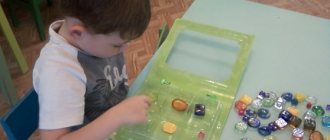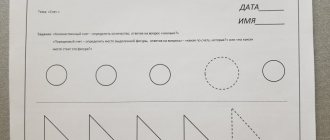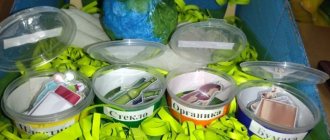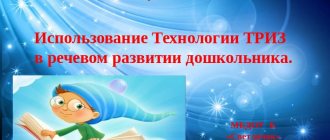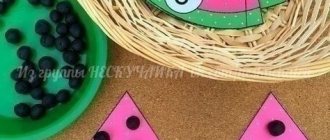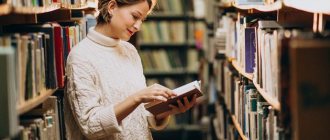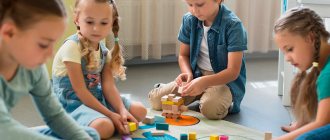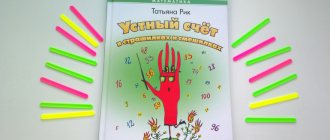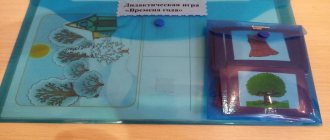Manuals for kindergarten teachers
The adoption of the Federal State Educational Standard for preschool education puts forward new requirements for teachers of children's educational institutions. They have to find new effective methods of interaction with preschoolers and apply non-traditional approaches in the use of various visual aids, objects, toys, and modern educational technologies. For this purpose, there are a variety of manuals for educators , which simplify the work of the teacher and help children learn the material more easily and easily.
It is not enough to have a large number of high-quality aids; it is also important to be able to use them competently so that students are interested in receiving information and can successfully assimilate it.
Types of benefits in the work of a preschool institution
In order for educators to effectively carry out their mission of teaching and educating the younger generation, they need to receive a large amount of competent modern information in full accordance with the directions of pedagogical science. This means that in their activities preschool teachers use numerous manuals, which can be divided into the following conditional groups:
- Manuals for training teachers. This is mainly pedagogical literature, textbooks, scientific developments of specialists in the field of teaching and upbringing of preschool children. At them, teachers learn the basics of their profession, gain the most important theoretical knowledge, which in the future they will effectively implement in their practical activities in preschool educational institutions.
- Methodological manuals for educators. This is an official publication that fully complies with the educational program and provides brief, but succinct and important information on a specific topic. It discusses the methods of education and training, that is, this document helps teachers determine the necessary steps and their sequence in working with children to obtain an optimal result. The theoretical side of the issue is considered minimally in the teaching aids, only to the extent necessary for a full understanding and assimilation of the topic.
- A visual aid for educators. These are various images of objects, objects and phenomena (flat or three-dimensional), used for teaching in order to form in students the correct concepts and ideas about the world around them, and to develop specific skills. Visual aids must meet numerous requirements, including selection by age of students, compliance with programs and teaching methods. They must also comply with sanitary and hygienic standards, be safe, aesthetically pleasing and useful for the development of children and the formation of a creative personality in them. Visual aids are among the most diverse things used in the work of a children's educational institution. They are usually divided into the following groups:
- Natural – natural objects.
- Fine – objects of painting, sculpture, graphics.
- Technical - video, audio, filmoscopes, records, televisions, players, computers and so on.
In the work of a teacher and educator, any benefit is of great importance. For one’s own development and self-education, which will later be reflected in practical work with children, textbooks and teaching aids are used. They form in the preschool educational institution specialist a correct understanding of the need to follow a certain methodology and training system, as well as the need to use innovative methods. All this is directly related to the modern attitude to the pedagogy of preschool education and the rejection of old forms, some of which have already lost their relevance, while others need to be revised and supplemented.
The importance of using benefits wisely
For the direct transfer of skills and abilities from teacher to student, the use of appropriate visual aids is of great importance. It is with their help that it will be easiest for a child to master complex concepts, since in this case various sensory groups are connected: vision, touch, hearing, and sometimes even smell. All this contributes to better assimilation, understanding and memorization of the material being studied.
An important role is also played by the fact that the use of such benefits takes place in an easy game form. Children do not feel pressure from an adult, easily absorb information, and have better contact with peers and with the teacher during play. These conditions are provided by a visual aid.
Sometimes teachers and educators have to make them themselves. At the same time, it is important that the finished product meets the specific goal of the preschool educational institution employee, is used taking into account the accepted methods of education and is suitable for children in the age group.
The success of using benefits during classes is ensured by compliance with the following conditions:
- High quality, allowing you to clearly see the object and eye-catching colors.
- Highlighting the main thing, which is especially important when demonstrating various illustrations, as well as competently thinking through and formulating age-appropriate explanations that should be understandable to students.
- Involving children in studying the manual and determining the information contained in it on their own.
At the same time, when doing this work, it is necessary to take into account the following facts:
- Too many benefits will only do harm, since children, due to their age, are not persevering and will not be able to assimilate excessive amounts of information.
- The manuals should be used in a specific order to avoid fragmentation of input and confusion that will not allow children to understand what is happening.
- Before starting classes, technical equipment, devices and aids must be checked and ensured that they are in working order.
- Individual benefits must correspond to the age of the pupils, because the benefits for the middle group will be incomprehensible to children, and the simplest “pictures” will not resonate with older children.
- The environment must be prepared for working with aids, providing sufficient space, good audibility and visibility, clarity of image and sound, and so on.
Taking into account all of the above, it becomes clear that any benefits play a huge role in the activities of the kindergarten teacher and in the work of the entire preschool educational institution as a whole. Educational and methodological aids are selected by the teacher taking into account his needs and the direction chosen for teaching students. Such benefits are also offered by the senior kindergarten teacher. They help make the learning and education process more harmonious and modern.
Visual aids were, are and remain one of the important tools for raising and teaching a child. With their help, you can develop various skills, form new skills and lay the foundations for deeper and more extensive knowledge. The goal of the teaching staff of the preschool educational institution is to select from the mass of proposed manuals exactly those that are best suited to a specific group of children and most accurately correspond to the chosen teaching and upbringing method in a preschool institution.
Program "Musical Masterpieces"
Author O. P. Radynova.
Goal: formation of the foundations of musical culture in preschool children, development of creative abilities in various types of musical activities.
The author offers a clear system of work based on the use of works of art, authentic examples of world musical classics.
The center of the program is the development of children’s creative listening to music, which involves encouraging children to demonstrate various forms of creative activity - musical, musical-motor, artistic.
The basic principle of constructing the program is thematic (the presence of 6 topics that are studied for one to two months and repeated on new material in each age group.
The program has developed methodological recommendations for teachers, a system of classes for all age groups in kindergarten, conversations, concerts, and entertainment.
The program provides an interconnection between cognitive, value-oriented and creative activities of children in the process of forming the foundations of musical culture.
The program is recommended by the Ministry of General and Professional Education of the Russian Federation
Programs for the social and moral development of preschool children
Program "I, You, We"
Authors: O. M. Knyazeva, R. B. Sterkina.
Goal: social and emotional development of a preschool child, the formation of his emotional sphere and social competence.
The program helps to solve a complex of problems related to the education of moral standards of behavior, the ability to build relationships with children and adults, to adequately resolve conflict situations, and to adequately assess one’s own capabilities.
The program includes the following sections:
- "Self confidence";
- “Feelings, desires, views”;
- "Social skills".
The content of the program is implemented on the basis of non-traditional variable lesson scenarios using a set of educational and visual aids for children’s independent activities.
Methodological recommendations are given to teachers and parents. The set includes educational and visual aids: “What are you like?”, “What do you like?”, “Happy, sad...”, “We are all different”, “How to behave?”, “Who are you friends with?”
Recommended by the Ministry of Education of the Russian Federation
Program “I am a man”
Author S. A. Kozlova.
Goal: to help the teacher reveal to the child the world around him, to form his idea of himself as a representative of the human race, about people living on Earth, about their feelings, actions, rights and responsibilities, various activities; on the basis of knowledge, develop a creative, free personality, with self-esteem and imbued with respect for people.
The program is aimed at developing a child’s worldview – his own vision of the world, his own “picture of the world”, consonant with the possible level of development of his feelings.
The program includes four large sections: “What I know about myself”, “Who are adults”, “Man is a creator”, “The Earth is our common home”. Each section has several subsections that specify its content. All sections of the program are interconnected, they complement each other, although each has its own specifics, its own educational goal.
The program presents requirements for the level of mastery of all sections, and also offers recommendations to parents, educators and primary school teachers. The program has methodological kits consisting of workbooks, sets of flashcards and teaching aids for adults.
The author has written a textbook “Theory and Methods of Familiarizing Preschool Children with Social Reality,” which can serve as a technology for implementing the “I am a Human” program.
The program is approved by the Department of General Secondary Education of the Ministry of Education of the Russian Federation.
Program "Spark"
Author L. E. Simoshina.
It is based on the provisions of the “Childhood” program. The content of the educational material is presented in two sections: theoretical and practical.
Theoretical assignments in the form of questions and answers are given at each lesson. In the practical part of the classes, it is recommended to use six options for motor-sensory organization of classes:
- movement and breathing;
- movements and visualization of the “picture of the natural world”;
- movements and musical accompaniment;
- movements and visualization of the teacher’s athletic appearance;
- movements and temperature contrasts of the environment;
- movements and a positive emotional state, as well as exercises of various types: health-improving, hardening, beautiful, cheerful, solemn and competitive.
The author claims and proves that one of the conditions for improving the physical condition of a preschooler is not the amount of physical activity, but the quality of motor actions and consistent interaction with dosed exposure to cold - hardening.
The technology for implementing the program comes down to general and special preparation of the child’s individual plastic image in a role-playing environment and in the air.
Heritage Program
Authors: M. M. Novitskaya, E. V. Solovyova.
Goal: introducing the child to Russian culture, introducing him to such spiritual values that are the connecting link between people.
The program consists of blocks that have relatively independent meaning and specific tasks:
- circle of events;
- family circle;
- reading circle
The authors have developed content materials for these blocks, holiday scripts, folk games, and a list of references. The authors use the traditional agricultural calendar for Russian culture, which reflects the rhythm of the annual life of nature and man in interaction with it. The Orthodox calendar acts as a form of folk traditions and memory of the history of the country and the world. The calendar of memorable dates reminds of various phenomena and events of Russian classical culture.
